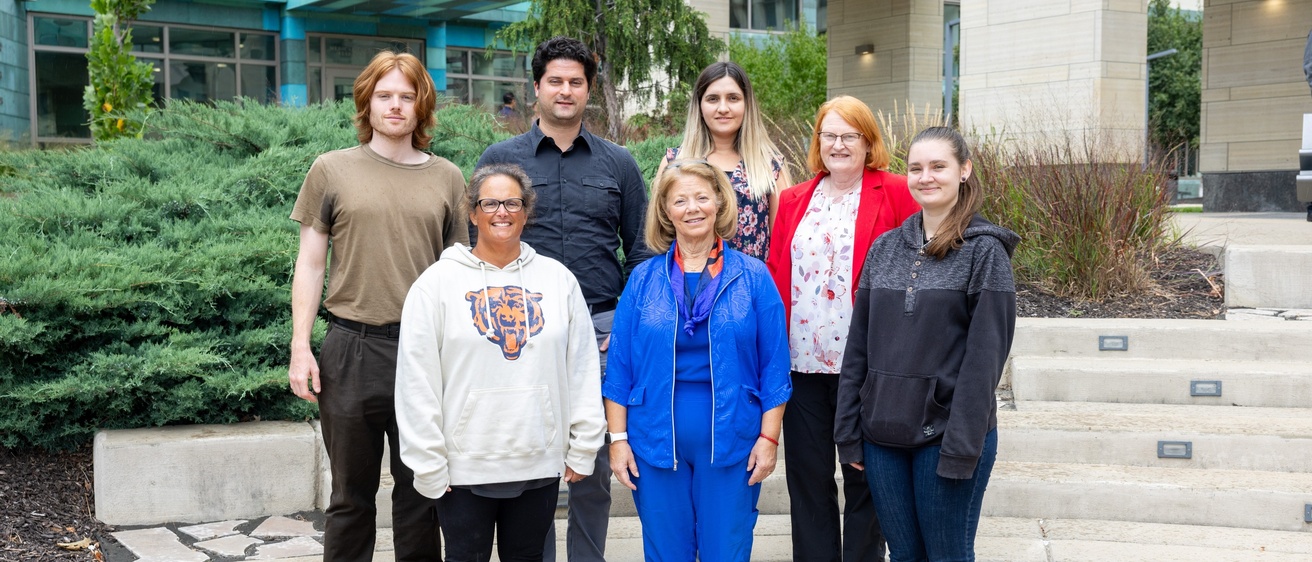Main navigation
Research Interests
Dr. Sluka's translational research laboratory focuses on a translational research musculoskeletal pain mechanisms and non-pharmacological treatments for chronic pain. These studies involve the use of animal models of muscle pain developed and characterized in Dr. Sluka's laboratory, as well as projects in human subjects. Current research projects involve 1) animal models investigating mechanisms involved in the transition to chronic pain, mechanisms of activity-induced pain, mechanisms of activity-induced analgesia, sex-differences in chronic pain; 2) biomarkers discovery research in several human pain conditions including post-surgical pain, fibromyalgia, ME/chronic fatigue, long-COVID; and 3) implementation of non-pharmacological therapies into clinical practice. Our overall goals are to improve the management of pain for people with a variety of musculoskeletal pain conditions by discovering the underlying mechanisms that lead to the development of chronic pain, discovering new therapies for pain management, and improving the use of currently available treatment for pain.
Cells of Life
Dr. Sluka is also an artist that visualizes the biology of the human body and disease. She regularly displays her work within the University of Iowa, the Society for Neuroscience annual meeting, and as an invited speaker and artist at other universities. Her artwork has been incorporated onto the covers of numerous scientific journals and within the latest version of her book, Pain Mechanisms and Management for the Physical Therapist.
Current Projects
Neurobiology of muscle pain
Goal: Examine the underlying mechanisms for how exercise can exacerbate pain
These studies involve examining the mechanisms that contribute to exercise induced pain. In people with chronic pain, acute physical activity and exercise can exacerbate their pain. Our laboratory has developed models of chronic muscle pain that involve repeated muscle insults or combining fatiguing stimuli with low-dose muscle insult to produce long-lasting widespread muscle pain. We are currently examining 1) the sex differences in the development of widespread pain, 2) the role of the immune system in the development of exercise-induced pain, and 3) sites, neurotransmitters, and receptors in the brainstem.
Funded by NIH AR073187
Recent References:
- Lesnak JB, Inoue S, Lima L, Rasmussen L, Sluka KA. Testosterone protects against the development of widespread muscle pain in mice. Pain. 2020;161(12):2898-2908.
- Sluka KA, Frey-Law L, Hoeger Bement M. Exercise-induced pain and analgesia? Underlying mechanisms and clinical translation. Pain. 2018 Sep;159 Suppl 1:S91-S97.
- Merriwether EN, Agalave NM, Daily DL, Rakel, BA, Kolker SJ, Lenert ME, Spagnola WH, Lu Y, Geasland KM, Allen LH, Burton MD, Sluka KA. IL-5 mediates monocyte phenotype and pain outcomes in fibromyalgia. Pain. 2020;162(5):1468-1482.
- Chimenti RL, Hall MM, Dilger CP, Merriwether EN, Wilken JM, Sluka KA. Local anaesthetic injection resolves movement pain, motor dysfunction, and pain catastrophizing in individuals with chronic Achilles tendinopathy: a nonrandomized clinical trial. J Orthop Sports Phys Ther. 2020;50(6):334-343.
- Oliveira-Fusaro MC, Gregory NS, Kolker SJ, Rasmussen L, Allen LH, Sluka KA. P2X4 receptors on muscle macrophages are required for development of hyperalgesia in an animal model of activity-induced muscle pain. Mol Neurobiol. 2020;57(4):1917-1929.
Exercise-induced analgesia
Goal: Examine the underlying mechanisms for how exercise can prevent and reduce pain
Regular physical activity and exercise is an effective treatment for existing chronic pain and can prevent the development of chronic pain. Our laboratory is examining the underlying mechanisms for how regular physical activity and resistance exercise can prevent the development of pain and reduce existing chronic pain using animal models. We exercise animals with running wheels to simulate regular physical activity, on a treadmill to simulate a regular exercise program, or with resistance training program and compare these to sedentary animals. We are currently examining: 1) the central mechanisms underlying this analgesia: sites, neurotransmitters, and receptors in the brainstem, 2) immune mechanisms underlying this analgesia, and 3) role of sex hormones in the analgesia.
Funded by NIH AR073187
Recent References:
- Lesnak JB, Sluka KA. Mechanism of exercise-induced analgesia: what we can learn from physically active animals. Pain Rep. 2020;5(5):3850.
- Sluka KA, Danielson J, Rasmussen L, Kolker SJ. Regular physical activity reduces the percentage of spinally projecting neurons that express mu-opiod receptors from the rostral ventromedial medulla in mice. Pain Rep. 2020;2;5(6):3857.
- Bobinski F, Teixeira JM, Sluka KA, Santos ARS. Interleukin-4 mediates the analgesia produced by low-intensity exercise in mice with neuropathic pain. Pain. 2018;159(3):437-450.
Effectiveness of transcutaneous electrical nerve stimulation
Goal: Test the effectiveness of TENS for pain during activity in people with fibromyalgia
Transcutaneous electrical nerve stimulation (TENS) is a non-pharmacological treatment for chronic pain commonly used by physical therapists. Our laboratory has discovered the underlying mechanisms for how TENS works using animal models and translating these findings into human subjects. We have discovered that TENS reduces central excitability and increases central inhibition in an opioid-dependent manner. We have subsequently shown that TENS is more effective for evoked pain such as hyperalgesia and pain during activity, when compared to resting pain. We recently completed a two-site clinical trial testing the effects of home usage of TENS during physical activity in people with fibromyalgia on a variety of outcomes measures including pain during movement, fatigue, psychosocial variables, function, and quality of life. We are now performing a pragmatic clinical trial determining if application of TENS to standard physical therapy care enhances reduction in movement-evoked pain and promotes adherence to physical therapy exercises.
Funded by NIH UH3/UG3 AR076387
Recent References:
- Vance KG, Pedelty J, Van Gorp BJ, Vance CGT, Johnson EM, Jiang F, Lafontant DE, Koepp M, Post AA, Bayman E, Chimenti RL, Dailey DL, Crofford LJ, Reisinger H, Sluka KA. Community engagement strategies improve recruitment and enrollment in a pragmatic clinical trial. J Clin Transl Sci. 2025 Jul 24;9(1):e184. doi: 10.1017/cts.2025.10103. eCollection 2025.
- Vance CGT, Dailey DL, Nakad L, Katz DA, Butler NR, Appenheimer SA, Gilbertson-White SH, Embree J, Daack-Hirsch SE, Sluka KA, Rakel BA. Contemp implementation of two non-drug pain prescriptions for musculoskeletal pain in primary care clinics. Clin Trials. 2025 Sep;156:108047. doi: 10.1016/j.cct.2025.108047. Epub 2025 Aug 11.
- Vance CGT, Dailey DL, Chimenti RL, Van Gorp BJ, Crofford LJ, Sluka KA. Using TENS for Pain Control: Update on the State of the Evidence. Medicina (Kaunas). 2022 Sep 22;58(10):1332. doi: 10.3390/medicina58101332.
- Vance CG, Zimmerman MB, Dailey DL, Rakel BA, Geasland KM, Chimenti RL, Williams JM, Golchha NM, Crofford LJ, Sluka KA. Reduction in movement-evoked pain and fatigue during initial 30-minute TENS treatment predicts TENS responders in women with fibromyalgia. Pain. 2020;62(6):1545-1555.
- Dailey DL, Vance GCT, Rakel BA, Zimmerman MB, Embree J, Merriwether EN, Geasland KM, Chimenti R, Williams JM, Golchha M, Crofford LJ, Sluka KA. Transcutaneous electrical nerve stimulation reduces movement-evoked pain and fatigue: a randomized, controlled trial. Arthritis Rheumatol. 2020;72(5):824-836.
Biomarkers of acute and chronic pain
Biomarkers have become increasingly important in improving diagnosis and prevention of disease, developing novel strategies for treatment of disease, and examining outcomes of effective treatments. 20-50% of individuals with acute pain after surgery will develop chronic pain 6 months later. The Acute to Chronic Pain Signatures Program is a large consortium that aims to determine biomarkers that predict which individuals are likely to transition from an acute postsurgical pain event to chronic pain, and which individuals are likely to be resilient to developing chronic pain. The study is longitudinal of resilence and susceptibility to chronic pain after surgery in 3,600 patients, incorporating a comprehensive set of psychosocial, neuroimaging, genomics, proteomics, lipidomics, and metabolomics biomarkers prognostic of the transition to chronic pain. We will combine a biomarker validation approach testing extant leading candidates with a discovery science approach aimed at identifying new mechanistic causes of pain and therapeutic targets. Our group serves as the Clinical Coordinating Center for the landmark study. Visit www.a2cps.org for more details on the A2CPS study.
Fibromyalgia is a condition that is diagnosed based on symptomology. It is difficult to diagnose and often goes undiagnosed for years delaying effective treatment. Our group recently discovered potential biomarkers in the citric acid cycle in individuals with fibromyalgia that are uniquely different from healthy controls. We are currently examining metabolic and immune biomarkers in fibromyalgia and their relationship to pain.
Funded by NIH U24 NS112873 and AR077418
Recent References:
- Sluka KA, Wager TD, Sutherland SP, Labosky PA, Balach T, Bayman EO, Berardi G, Brummett CM, Burns J, Buvanendran A, Caffo B, Calhoun VD, Chang A, Coffey CS, Dailey DL, Ecklund D, Fiehn O, Fisch KM, Frey Law LA, Harris RE, Harte SE, Howard TD, Jacobs J, Jacobs JM, Jepsen K, Johnston N, Langefeld CD, Laurent LC, Lenzi R, Lindquist MA, Lokshin A, Kahn A, McCarthy RJ, Olivier M, Porter L, Qian WJ, Sankar CA, Satterlee J, Swensen AC, Vance CGT, Waljee J, Wandner LD, Williams DA, Wixson RL, Zhou XJ, A2CPS Consortium. Predicting chronic postsurgical pain: current evidence and a novel program to develop predictive biomarker signatures. Pain. 2023 Sept 1;164(9):1912-1926. doi: 10.1097/j.pain.0000000000002938. Epub 2023 Jun 15.
- Berardi G, Frey-Law L, Sluka KA, Bayman EO, Coffey CS, Ecklund D, Vance CGT, Dailey DL, Burns L, Buvanendran A, McCarthy RJ, Jacobs J, Zhou XJ, Wixson R, Balach T, Brummett CM, Clauw D, Colquhoun D, Harte SE, Harris RE, Williams DA, Chang AC, Waljee J, Fisch KM, Jepsen K, Laurent LC, Olivier M, Langefeld CD, Howard TD, Fiehn O, Jacobs JM, Dakup P, Qian WJ, Swwensen AC, Lokshin A, Lindquist M, Caffo BS, Crainiceanu C, Zeger S, Kahn A, Wager T, Taub M, Ford J, Sutherland SP, Wandner LD. Front Med (Lausanne). Multi-Site Observational Study to Assess Biomarkers for Susceptibility or Resilience to Chronic Pain: The Acute to Chronic Pain Signatures (A2CPS) Study Protocol. 2022 Apr 25;9:849214. doi: 10.3389/fmed.2022.849214.eCollection 2022.

Kathleen A. Sluka, PT, PhD, FAPTA
Director
Location
3148 Medical Laboratories
Phone: 319)-384-4442
